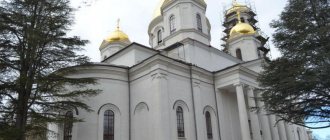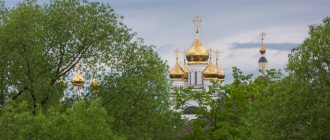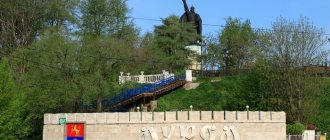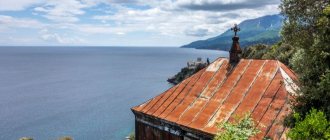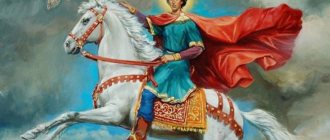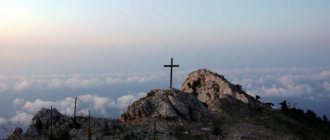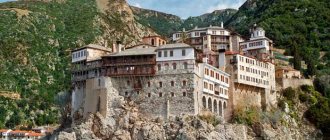Athos is the Holy Mountain in Greece with the status of an autonomous monastic state uniting 20 Orthodox monasteries. Saint Athos is revered as the earthly inheritance of the Mother of God, under her special protection. Therefore, it is not surprising that the world of the Athos icon is, first of all, images of the Mother of God. Many Athonite icons of the Blessed Virgin Mary date back a thousand years or more, and copies of them have spread throughout the Orthodox world.
More than once the Athonite icons showed real miracles. It is believed that prayer in front of the Blessed Virgin heals the body and soul, brings peace to it, and strengthens faith.
Miraculous Icon of Our Lady of Iveron
The history of this icon from Athos is amazing. In the 9th century, when iconoclasm reigned, when icons were destroyed, they tried to confiscate the icon of the Mother of God from one pious widow. When the warrior hit the icon with a spear, blood flowed from the icon. The woman with a prayer took it to the sea, launched it across the waves, and the icon moved along them standing upright.
Two centuries later, monks from the Athos Iveron Monastery again found the icon, and it itself ended up above the gates of the monastery, for which it was called the “Goalkeeper” in addition to the name “Iverskaya”.
Celebration is Tuesday of Bright Week.
History of the New Athos Monastery
The monastery began its history at the beginning of the 19th century. At that time, a donation of a considerable sum of money was allocated from the royal treasury to the monks of the Russian monastery in Greece. In addition to funds, land was also allocated, which was notorious. A Christian missionary in the Caucasus died on it in the first century. And in principle, in its appearance the mountain itself was somewhat reminiscent of the well-known Greek Mount Athos.
The best article for you, go to: Spaso-Andronikov Monastery
Construction began according to the design put together by the architect Nikonov. The mountainous terrain was inaccessible and quite difficult to develop. But despite this, the monks leveled it a little - they filled up the chasms and improved the soil. The buildings themselves had two parts - upper and lower. Soon a shelter for pilgrims, the Church of the Intercession of the Mother of God and outbuildings were built. The most important pride of the complex was a special school for boys.
This men's monastery became the center of Orthodoxy on the territory of the Black Sea coast of the Caucasus. Thousands of tourists and pilgrims visit it every year. It should be noted that there were also eminent guests such as Prince Mikhail Romanov, Emperor Nicholas 2, etc.
The monks put a lot of work into the arrangement of the monastery. With their hands, a pier for passengers and cargo and a hydroelectric power station were built. Moreover, the monks had their own railway and even a steam locomotive. Fruits were grown in the gardens, there was also an apiary, a stud farm and a winery. The scope and influence of the monastery were truly enormous.
With the advent of Soviet power, truly difficult times began for the monastery. For more than five years, the monks tried to protect and defend the complex, but unfortunately, it was closed. And only in the early 90s he began to “rise from his knees.” Divine prayers began to sound within the walls of the building again. In 2001, a college and regency school opened. But despite this, repair work on the territory of the monastery is still ongoing.
The best article for you, go to: Temple in Maryino “Quench My Sorrows”
Icon of the Mother of God "Tricherussa" ("Three-Handed")
Many images here are known as miraculous icons of Athos.
These include the Three-Handed Lady, which belonged to St. John of Damascus. When, at the slander of slanderers, the Saracens cut off his hand, he turned to the icon for healing, and a miracle happened - the hand grew to the same place. St. John, in honor of this miracle, made a silver brush and attached it to the icon. Subsequently, the image was presented to the Archbishop of Serbia, but when Serbia was attacked by enemies in order to save the icon, they put it on a donkey and let this donkey go wherever it looked. He himself came to Athos to the Hilendar monastery. For a long time after the death of the abbot, they could not choose a new one, and then the Mother of God appeared in a dream to one recluse and announced that she herself would become the abbess of this monastery. To this day, it is managed by a priest-regent, and the “Three-Handed” icon stands in the abbot’s place.
Celebration – July 11th.
How to get there
Address: Republic of Abkhazia, New Athos (Anakopia), monastery of St. Apostle Simon the Canaanite. To get to the New Athos monastery, you must first get to the Russian resort of Adler, 8 km from the Abkhaz border, then cross the Psou border post. Next, after passing passport and customs control, you need to take a regular bus, which will take you to New Athos in 3 hours.
May the Lord protect you!
You will also be interested in watching a video about the holy monastery:
Icon of the Mother of God “It is Worthy to Eat”
This icon of Athos has its own wonderful story. In 982, an old man and a novice lived in a cave near Kareya. When the elder went to the all-night vigil, an unknown monk appeared in his cell at night and began to pray together with the novice. When they sang the prayer “Most Honest Cherub,” the monk added to the chant “It is worthy to eat...” (and further, this is how this song is sung today).
The monk, at the request of the monk, wrote down these words, but not on paper, but on a stone slab with his finger, which became like wax. Having given his name - Gabriel, the monk disappeared. It was Archangel Gabriel.
Celebration – June 24.
New Athos
In New Athos, a double room at the Griffin Hotel was booked and paid for in advance. The cost is 1000 rubles per day for 1 person with an additional folding bed. The room is located on the 3rd floor and includes: toilet, shower, TV and air conditioning. In addition, there is an iron and ironing board in the hallway. On September 10, 2014 at 16-00, we flew from Sheremetyevo airport to Sochi. And after 8 hours we settled in at night (about 24 hours) in New Athos. Therefore, our acquaintance with Abkhazia began early in the morning.
Icon of the Mother of God “Sweet Kiss” (“Glycophilus”)
According to legend, this icon is one of the seventy that the Evangelist Luke himself painted. He depicted the Mother of God kissing the Baby Jesus. The icon has shown miracles more than once. So, during the Second World War, when Greece was occupied by the Germans, the Philotheevsky Monastery almost ran out of wheat, there was nothing to feed the monks and lay pilgrims, but in the hope of the help of the Blessed Virgin, the monks baked bread from the last flour.
Soon a ship moored to the monastery, and the captain offered the wheat the ship was carrying in exchange for firewood. This is how the Mother of God took care of Her children.
Celebration – April 30.
First impressions
Leaving the hotel at 6 o'clock in the morning, I gasped. I have never seen such beauty in my life. The fast mountain river Psyrtskha flows right in front of the hotel. And behind it, in the background, is a view of the unforgettable mountainous terrain. The hotel itself is built of wood and harmonizes perfectly with the surrounding landscape of green slopes.
I admire the beauty of New Athos
From the huge loggia of our room we had a view of the picturesque steep slope of Iveron Mountain, covered with greenery and numerous buildings. And when leaving the hotel, immediately behind the houses across the street, one could see the thickets of the huge Mount Athos. The surrounding panorama immediately lifted my spirits. And the clean mountain air mixed with the wonderful aromas of subtropical plants turned my head. The Black Sea is less than half a kilometer from the hotel (7-10 minutes of a leisurely walk).
Icon of the Vatopedi Mother of God “Consolation” or “Consolation”
The monastery got its name from the word “vatoped”, translated from Greek as “bush of a youth”. As legend says, in 390, the young son of Emperor Theodosius the Great, Arkady, fell from a ship into the sea, but by the grace of the Mother of God he ended up on the shore and fell asleep under a bush, where he was found the next morning.
In gratitude, the emperor ordered the construction of a new monastery on this site.
Celebration - February 3.
Trip to New Athos
We were there in 2007.
Unfortunately, I didn’t immediately write a report about the trip, and now a lot has been forgotten ((All that remains is the feeling of God’s Grace experienced there. But nevertheless, I really want to share with you. Below is a photo of the trip with small comments, a video file from the evening vigil in New Athos Simon-Kananitsky Monastery (the quality is terrible, but still there are some views of the temple and you can hear the progress of the service, Byzantine chant) I will post a video file with a 25-minute film about New Athos in a separate post.So be careful if you are saving traffic.
1. On the road to New Athos, not far from the Russian-Abkhaz border. Church-Basilica of St. Venerable Hypatia of Gagrinsky VI century.
2. New Athos Simon-Kananitsky Monastery
The New Athos Monastery , which gave its name to the surrounding area, was founded in 1875 by monks who came from the Russian St. Panteleimon Monastery on Athos. The place for the monastery, on behalf of the Athonite elders, was chosen by Hieromonk Arseny (Minin) , a resident of the Panteleimon Monastery, who obediently spent many years in Russia, the founder of the famous Athos Chapel in Moscow before the revolution, buried in the cemetery of the Novo-Alekseevsky Monastery. The place on the mountains of which the holy monastery appeared has an ancient history. Even before the birth of Christ, the village of Pstsyrkha was located here (the name means “Fir Spring” and was borrowed from a mountain river flowing nearby). In the Middle Ages, an impregnable fortress of Anakopia was built on a mountain near Pstsyrkhi (this name comes from the Abkhazian “anakop” - ledge), which was the capital of the principality of Abazgia, and then of the Abkhazian kingdom (also known in Byzantine sources as Trachea).
3. Temple of St. Apostle Simon the Canaanite, 10th century. (date from the description of the pilgrimage trip; in the excerpt below, the date of construction is indicated in the 6th century)
In the first century, the apostles Andrew the First-Called and Simon the Canaanite preached here . The Apostle Andrew went to continue his preaching to the north, reaching Kyiv, and then the island of Valaam. And St. Simon the Canaanite remained in Pstsyrkh, settling in a stone cave not far from the village. Many residents accepted faith in Christ according to his word, but others, having become hardened, crucified the preacher on the cross, and he accepted a martyr’s death in imitation of the Beloved Savior, for Whom he worked. Apostle Simon the Canaanite is the same man at whose wedding the Lord turned water into wine. Struck by this miracle, and even more so by the very personality of the God-Man, Simon left his family home and followed Christ, becoming one of His twelve Apostles. For his zeal for Bose, he was called Zealot, which means “zealot” (the name Canaanite indicates origin from Cana of Galilee). The cave where St. labored. Simon Zelot, located in the gorge of the Pstsyrkha River (behind the waterfall and the Pstsyrkha railway station). The place of the apostle's martyrdom is indicated by a stone cross on the river bank. Over the grave of the saint in the 6th century. A beautiful temple was built, which has survived to this day.
The monastery itself was built in a place sacred to every Christian - near the ancient temple of the Apostle Simon the Canaanite, where his holy relics rest in secret!
4 The monastery buildings are a hydroelectric power station.
Working under the guidance of specialists, the monks (at the very beginning of the twentieth century!) created their own hydroelectric power station, for which they built a dam on the Pstsyrkha River (this is how a waterfall appeared, which to this day attracts guests of New Athos). The waterfall was also used as a kind of refrigerator - ice was placed in the cave, protected from the sun by its cold streams, in winter, which did not melt all summer. There was a brick shop, a watch shop, a foundry shop, a painting shop, a bookbinding shop, etc. workshops.
5 Just a beautiful waterfall on the territory of the monastery - these thin stripes are streams of water flowing down the leafy moss.
6 Monastery Railway, now inactive.
In 1888, New Athos was visited by the Sovereign Emperor Alexander III with his Heir, Tsarevich Nicholas (future Tsar-Martyr Nicholas Alexandrovich). After praying at the monastery, visiting the cave of Apostle Simon the Canaanite and inspecting the monastic household, the Emperor and the Heir sailed on their own yacht to Novorossiysk. Upon returning from this journey, an attempt was made on them, but the Lord preserved His Anointed One. In gratitude for deliverance from danger, the Emperor gave the New Athos Monastery a steam locomotive. It was useful to the monks to perform an important obedience: transporting valuable wood from the high mountains surrounding the monastery. For this purpose, the monastics laid a narrow-gauge railway to the top of Mount Athos. The accuracy of the calculation was such that the carriages loaded with timber rolled smoothly to the coast without additional traction, while the empty train was pulled up the mountain by a steam locomotive donated by the Tsar. This historical train is still one of the attractions of New Athos today. The road leading to it starts from the monastery.
7 On the way to the cave of Simon the Canaanite
600 meters from the city center, upstream the Psyrtskha River, there is a small grotto where, according to legend, Simon the Canaanite . This grotto was consecrated in 1884 and is now often visited by pilgrims and tourists. It is called the Grotto of St. Apostle Simon the Canaanite.
In this cave, our pilgrimage group read an akathist (one at a time in parts) - this was the first akathist in my life).
In the gorge you can see another Christian shrine - the rock footprint of Simon the Canaanite. According to a legend existing in Abkhazia, when local residents did not believe Simon the Canaanite that he was one of the apostles of Christ, he became angry and stamped his foot, leaving evidence - a mark on this stone.
8 Psyrtskha River.
The air is about 30 degrees, the water is about 6, which is why there is such a haze over the water. A little higher is the place of death of Simon the Canaanite. Our first bath in the holy spring took place there. Our guide (a very religious and church-going person, I don’t remember exactly what relation he has to the church, but the most direct thing is for sure) with the words “In the name of the Father, and the Son, and the Holy Spirit,” poured three times on the head of each pilgrim. a bucket of water from a source. I could only stand one thing)
9 Landscapes of the Psyrtskha River
By the grace of God and the prayers of St. Apostle Simon the Canaanite, at the site of his martyrdom, gushed into a spring, the waters of which flow into the Psyrtskha River. This place is impossible not to notice, as the stones around it have red spots. According to church tradition, the apostolic blood soaked into the rocky banks of the river and for centuries silently testified to the “zeal for God” of St. Simon.
I don’t have a photo of these stones, so I stole it from one of the sites, the address is marked on the photo.
10 Blood of Simon the Canaanite
11 Main temple of the monastery
The main temple of the monastery is dedicated to the great martyr and healer Panteleimon, the patron saint of the Russian Athos Monastery. Also in the monastery churches were built in the name of the Apostle Andrew the First-Called, St. Hieron, Ascension of the Lord. The interior decoration of the Panteleimon Church at the same time resembles Athos and does not let us forget that we are still within the Russian Empire. Along the walls there are carved wooden stasidias, and from the vaults of the temple, faces painted in the Vasnetsov style look down on the worshipers - the church was painted by Moscow artists under the direction of N.V. Molova and A.V. Serebryakov and the Volga Bogomaz artel, led by the Olovyannikov brothers. The huge cathedral of the monastery today is rarely filled with worshipers, but before the revolution, 730 brethren labored in the New Athos monastery.
12 Video from the evening vigil:
Watch here - https://www.babyblog.ru/community/post/pravoslav/1508236
The revolution that broke out in 1917 brought ruin and closure to the New Athos Monastery, and many of its inhabitants received martyr's crowns. According to legend, the atheists took the monks on a ship to the middle of the New Athos Bay and drowned them, tying heavy stones around their necks. They say that in our days divers saw the incorrupt bodies of martyrs standing at the bottom of the sea. Monastic robes and beards sway with the quiet current... So, the water of New Athos Bay is holy - sanctified by the suffering feat of those killed for their faith. The monastery was closed in 1924. Not far from it, one of Stalin’s many dachas was built (today, part of its territory - the building where the guards lived - is occupied by the boarding house "At the Monastery"). The monastery premises housed a tourist center and a local history museum. But spiritual life in the vicinity of New Athos did not die. Hermits continued to escape in the deserted mountains. During the years of state atheism, their number increased: with the almost complete absence of monasteries, the Caucasian “desert” sheltered those seeking prayerful solitude from all over Russia - both men and women. In the seventies of the 20th century, the famous Glinsky elder Schema-Archimandrite Seraphim (Romantsov) came to care for the hermits, who settled in Sukhum after the closure of his native monastery. New Athos was visited more than once by another one of the ascetics of the 20th century, schema-abbot Savva (Ostapenko).
Schema-abbot Savva is credited with finding the lost site of the third discovery of the head of John the Baptist. This place is a small cave near the village of Kaman. It was here in the 9th century that the Orthodox hid from the iconoclasts a great shrine - the Honest Head of the Baptist of the Lord. But this is not the only thing that makes Kaman famous. martyr Basilisk suffered here and a hundred years later it was in this village that the great saint John Chrysostom, dragged into exile by merciless soldiers, gave up his spirit. Exhausted by the difficult journey, illness and cruelty of his companions, who did not allow him to rest his exhausted body, the saint, on the eve of his death, saw in a vision Saint Basilisk. “Tomorrow we will be together!” - the martyr predicted to the sufferer. With the words “Thank God for everything!” St. John gave up his soul in the hands of God and was buried in Kaman. His stone sarcophagus is still reverently kept in the Kaman Church, and the relics of the saint, 30 years after his departure from earthly life, were honorably transferred to Constantinople, to the place of service of St. John Emperor Theodosius is the son of those who sinned against the saint of God Eudoxia and Arkady.
13 Mountains and a destroyed bridge in Kaman.
I want to say separately what Kaman (Komany) is. You can only get to this place by UAZ or some super-mega SUV. Because in many places there are simply no roads. We were driving this UAZ from New Athos through Sukhumi, disfigured by the war: you look along the road, and there is a hole in the house from a shell, a real hole the size of a room. Look, people live around this hole, laundry is hanging..... I’m simply silent about the number of dilapidated and abandoned houses in Sukhumi. From Sukhumi the road goes into the mountains, through completely abandoned mountain villages. This is a truly creepy sight. An entire village with large, formerly rich-looking houses, with luxurious gardens, stands empty and dilapidated...
It must be said that there was heavy rain all the way from New Athos to Kaman. Therefore, when we got directly to Kaman (by that time the rain had just stopped), we saw a stormy mountain full-flowing river, the bridge over which was destroyed during the war. In normal conditions (without rain) they ford across it in these UAZs, but in unusual conditions...
14 Crossing the river to Kaman
...and in an unusual one - on a bungee like this: they send passengers out, and pull it back on a rope. It's creepy, I tell you...
15 Church of the Holy Martyr. Basilisk
16 Grave of the Holy Martyr. Basilisk
The holy martyr Basiliscus was the nephew of the holy martyr Theodore Tiron (February 17) and suffered with his brothers Eutropius and Cleonikos during the persecution of Christians by the emperor Maximian Galerius (305 - 311). The holy martyrs Kleonikos and Eutropius were crucified on crosses (their commemoration is March 3), and the martyr Basilisk was sent to Comana, where he was kept in prison. The ruler Agrippa, arriving in the city of Amasia, began to persecute Christians. Saint Basilisk in prison was preparing for the upcoming martyrdom. In a dream, the Lord appeared to him, promising the martyr His help, and predicted his martyrdom in Comana. Saint Basilisk asked the prison guards to let him go to his native village to say goodbye to his family. He was released because he was revered for the holiness of his life and the miracles he performed. Arriving home, Saint Basilisk informed his relatives that he would see them for the last time, and convinced them to stand firmly for their faith.
When Agrippa learned that Saint Basilisk had been released to his relatives, he became furious. Having cruelly punished the prison guards, he sent for the martyr a detachment of soldiers led by the cruel magistrian (ruler's assistant). Having met the returning Saint Basilisk, the magister put heavy shackles on him, put copper boots on his feet with nails driven into the soles, and sent him to Comana.
Having reached one village, on a hot afternoon, the travelers stopped in the house of the woman Troyana. The soldiers went to the house to rest and refresh themselves with food, and they tied the holy martyr Basilisk to a dry tree. Standing in heavy chains under the hot sun, the saint prayed to God. Suddenly a Voice was heard from above: “Do not be afraid, I am with you.” The earth shook and a spring gushed out of the rock. Magistrian, the soldiers and Trojan, frightened by the earthquake, ran out of the house. Amazed by the miracle that had occurred, they freed the martyr. Sick residents of the village came to the holy martyr and received healing through his prayer.
When the martyr finally appeared before Agrippa, he ordered him to make a sacrifice to the pagan gods. The martyr replied: “I offer God a sacrifice of praise and thanksgiving every hour.” He was taken to the temple, where fire instantly descended from Heaven on Saint Basilisk, which burned the temple and crushed the idols standing in it to dust. Then Agrippa, in helpless rage, ordered that Saint Basilisk’s head be cut off and his body thrown into the river. The death of the martyr followed in 308. Christians soon bought the holy relics of the martyr and secretly buried them at night in a plowed field. After some time, a church was built on this site in the name of the holy martyr Basilisk, into which the relics were transferred. Through the holy prayers of the martyr, healings began to take place. Before his death in Comana, the holy martyr Basilisk appeared to Saint John Chrysostom (November 13) and said: “Tomorrow we will be together.” The feat of the holy martyr Basilisk was told to the world by an eyewitness of his suffering, Saint Eusignius (August 5).
The temple-chapel was built quite recently with the money of a father whose daughter was miraculously cured of a serious illness through water from the source of St. Basilisk.
17 Bathing in the spring of the Holy Martyr. Basilisk
18 Echoes of war near the source of St. Martyrs. Basilisk
19 God’s gift to tired pilgrims on the way to the temple is holy. John Chrysostom
After bathing in the spring and a camp lunch, we headed to the monastery of St. John Chrysostom. On the way we saw a clearing with an incredible amount of ripe blackberries. Having lived all my life in Kuban, I have never seen so many blackberries.
20 Holy Temple John Chrysostom
On the left side of the country road, which runs along the flow of the Western Gumista (the river through which they crossed on a bungee), you can see the ruins of the Basilisk-Zlatoust monastery, founded in 1898. The number of nuns in it reached 300 people, which allowed the monastery to conduct large-scale economic and educational activities. During Soviet times, a nursing home was located in the destroyed monastery buildings. Now only a few male monks live in the monastery.
The Temple of St. John Chrysostom rises a little further above the river. The temple was rebuilt in 1991 on the ruins of an ancient temple of the 11th century, which was a single-hall stone structure without an apse protruding outward, with an internal altar semicircle. The room was illuminated by two narrow windows located in the altar and in the western wall. At the end of the 19th century, two chapels and a three-story bell tower were added to the temple. The clearing around the temple was surrounded by a stone wall, as it is today.
The next day after our trip to Kaman, we climbed Mount Anakopia.
21 New Athos, holy spring on Mount Anakopia (Iveron)
The mountain on which the monastery raised its heads to the sky was named Athos, and the one adjacent to it, the same one on which the remains of the Anakopia citadel are located, was named Iveron - in honor of one of the main shrines of Athos. Construction of a temple and a hotel for pilgrims began in the ancient fortress, but was not completed due to the disaster of 1917.
One of the “miracles” of the mountain fortress is an inexhaustible well, which has been attracting the attention of pilgrims and now tourists for eighty years. The origin of this well is usually explained by the fact that water enters it through a natural channel, operating on the principle of communicating vessels, from the neighboring Mount Athos or even more remote places where there is a stable level of glacial waters.
However, Iverskaya Mountain does not contain anything that could justify the assumption of the existence of a natural vertical channel through which water could rise to the top. The surface of the mountain is covered with cracks, through which all the rainwater seeps deep down, freely reaching the level of the Anakopia abyss and going below.
22 Ruins of a temple on the top of Mount Anakopia
The walls of the 7th century temple have also been preserved. Today, among the ancient ruins, there is a lovingly decorated chapel, where you can light a candle in front of the image of the Iveron Mother of God and read the akathist to the Most Pure One.
23 Chapel of Our Lady of Iveron on the top of Mount Anakopia
24 View from the top of Mount Anakopia
25 Abkhazia. This is how pomegranate grows
26 And so - persimmon
Source: https://www.babyblog.ru/community/post/pravoslav/1508236
Places: New Athos Monastery Temple of St. Apostle Simon the Canaanite in New Athos Temple of St. Hypatia of Gagra in Gagra Temple of St. John Chrysostom in the village. Comana Holy Spring of St. Basilisk Temple of St. Basilisk
If you liked the review and you also want to visit these shrines, then we invite you to familiarize yourself with the corresponding pilgrimage tours.
Comments
- Posted by Biruklens26 November 14
Thank you! Mom once upon a time, even before the opening of the monastery (in the 80s), was in New Athos. We read your article as if we were with you!
Please login or register to add comments.
Runaway Groom
There are not many apostolic places on earth where the Savior’s disciples preached. And New Athos is one of these points on the map. Simon the Canaanite is one of the closest disciples of Jesus Christ. It was at his wedding in Cana of Galilee, in the midst of the holiday, that the wine ran out. Then Jesus Christ performed His first miracle - turning water into wine, which almost all the evangelists talk about. After this miracle, Simon will believe in Christ and follow Him, leaving his bride.
After the descent of the Holy Spirit on the apostles, the Good News spread throughout the world: Thomas went to India, Peter to the Romans, Luke to Greece. And Simon the Canaanite went to preach together with Andrew the First-Called in Ossetia and Abkhazia. After the city of Sevasta (present-day Sukhum), the apostolic paths diverge: the Apostle Andrew goes further along the Black Sea coast of the Caucasus, reaching Bulgaria, and Simon remains here, settling in a cave in the gorge of the Psyrtskhi River. Here he lives, preaching the Gospel of Christ to the pagans.
In 1884, the monks of the Panteleimon Monastery equipped the cave as a chapel. Now stone paths along the stream lead to it, and this place is called a “park-reserve” and entry is paid.
The best time to visit the Apostle's cell is early in the morning. We arrived before the park opened. At the entrance we were met by an Abkhaz grandfather, apparently a caretaker. We started talking. “Pilgrims, or what?” Tourists don't come here this early.
At this pre-dawn hour here in the park, it is especially quiet and mysterious. The sun has not yet broken through the green canopy of trees, the forest freshness is invigorating. There are still no visitors, no guides offering to “recharge with positive energy from the feet of the Apostle Simon”... There is no one - and the earth seems to remember the past millennia. And if you don’t look at your feet, at everything created by man - paths, bridges, urns, signs - then you can imagine how everything was 2000 years ago, when Christ’s disciple walked on these stones.
Anakopia Fortress
You can see the entire panorama of the city by climbing the tower of the ancient fortress on the top of Iverskaya Mountain. The climb there is not dangerous, but it will take at least an hour and require a lot of effort. The road winds along the slopes of the mountain along the ruins of four defensive lines built from the 2nd to the 8th centuries AD. On these walls the Abazgians repelled the attacks of the Byzantines and Arabs. There are no fences; you can climb and take pictures on the ruins of walls and towers.
More on the topic: Sukko – the valley of juniper aromas
Road to Iverskaya Mountain
At the very top of the mountain is a citadel, made of huge snow-white limestone blocks. Around it are the remains of palace buildings and temples. Once upon a time here was the capital of the Abkhazian kingdom and the princely court was located. Near the surviving altar wall of the Church of St. Theodore Tiron, built in the 6th century, the monks of the New Athos monastery built a small chapel in which you can light candles and pray. Nearby there is a well with clean spring water to refresh your strength before climbing the tower.
Tower in the Anakopia fortress
The crenellated tower of the Anakopia fortress offers stunning views of the city and the sea coast. From here you can once again take a look at all the sights - the New Athos Monastery, the Temple of Simon the Canaanite, the lake at the waterfall, the railway station, the sea pier and the Swan cafe in the Seaside Park.
Inside the Iveron Mountain there is another attraction - the famous New Athos Cave. But this object deserves a separate story.
Bedia Cathedral
The small village of Agu-Bedia is widely known not only throughout Abkhazia, but also beyond its borders. What made it famous was the ancient Bedia temple, built during the reign of the Abkhazian king Bagrat III (999). The place he chose among the mountains made the cathedral and the surrounding buildings a reliable citadel. On the day of the opening of the sanctuary, the king and queen mother presented a golden cup (chalice) as a gift to the temple.
Today, a valuable vessel and a beautiful piece of jewelry is in the Tbilisi Museum of Art. The cross-domed structure was consecrated in honor of the icon of the Mother of God of Blachernae (today northwest of Istanbul). Currently, the image of the patroness of the Byzantine emperors is kept in the Assumption Cathedral in Moscow.
The Bedia Cathedral was built in the Byzantine style; its architecture embodied the features of other Christian monuments of that era. The massive walls are made of rough gray stone. The internal space is divided into 3 rooms: a central hall and 2 side rooms, separated from it by an arched colonnade. Only fragments of the wall paintings remain.
The western wall is decorated with the image of the Byzantine Emperor Constantine as the protector of Christians. The Bedia Cathedral was active until the Ottoman invasion in the early 17th century. It was abandoned for almost 2 centuries and underwent restoration at the end of the 18th century. Its facades and dome were updated. Near the religious monument you can see the ruins of the bishop's palace - an object of interest for tourists.
Blagoveshchensky cathedral
The architectural decoration of the center of Sukhum - the Annunciation Cathedral attracts attention with its graceful lines and beauty. Its shining dome with a cross is clearly visible from the sea. It was erected in 1909 by Greek monks in honor of St. Nicholas. Later it became known as Annunciation Cathedral, acquiring the status of the Cathedral of the Sukhumi-Abkhaz diocese.
Abkhaz metropolitans stay here today and clergy are ordained. Built in the neo-Byzantine style, the white building looks magnificent after its reconstruction in 2010. A new dome, made using the most modern technologies, has been installed.
The dome cells are made of stainless steel coated with a nitrotitanium layer that imitates gold plating. Unique Orthodox shrines are kept inside. Parishioners worship iconographic images of saints, including Andrew the First-Called, John Chrysostom, and others.
There is a true rarity here - the icon of Panteleimon with the relics of the holy healer. Until 1990, the ashes of John Chrysostom were kept in the cathedral, which were later transferred to the Kamansky temple. Parishioners especially venerate the iconographic faces of St. Simon the Canaanite, the Iveron Mother of God. As a sign of memory of St. Nicholas the Wonderworker, services are held in the chapel named after him. There is a Sunday school at the cathedral.
Pitsunda Temple
Located on the territory of the Great Pitiunt nature reserve in the center of Pitsunda, the Cathedral of St. Andrew the First-Called is the brightest monument of Christianity. It was built in the 4th century AD. e. in honor of the holy apostle who preached the faith of Christ in the 1st century AD. e. He is considered the founder of the Abkhazian Church along with Simon the Canaanite. Their relics rest in the cathedral tomb.
The Patriarchal Cathedral (its other name) received its modern appearance in the 10th century. The magnificent building amazes with its mighty architecture, reminiscent of a fortress. The thick walls, made of wild stone and brick, impress with their power. At the bottom of the building there is a tomb painted with amazing frescoes.
In 1975, the cathedral was converted into a concert hall. The icons, mosaics, and crosses were taken to the Tbilisi Museum. A rare German-made organ with a unique sound was installed in the room. Crowds of people come here to see the cathedral, the ruins of other ancient buildings and listen to organ music. Inside the sanctuary, medieval paintings have been preserved; the dome is decorated with a fresco with the face of Christ.
Visitors go up, sitting on small balconies from which the stage with the organ is clearly visible. The sound is so strong that the vibrations cause the paint to peel off from the frescoes. The issue of moving the instrument to another place is now being decided in order to preserve the valuable paintings.
- What to see in Abkhazia by car - 20 most interesting places
- 10 best resorts in Abkhazia for families with children
- 20 most beautiful places in Abkhazia
- Sights of Abkhazia
Chapel of Alexander Nevsky, Genoese fortress and Church of the Intercession
The New Athos Monastery was also supported by Emperor Alexander the Third. In memory of his arrival in 1888, the Alexander Nevsky Chapel was built, which stands in the Primorsky Park opposite the pier. And a little further on the embankment are the remains of a medieval Genoese fortress. The monks rebuilt one of the Genoese towers into a hotel, and dismantled the second tower and the remains of the fortress walls to use the stones to build a monastery.
More on the topic: Fascinating Abkhazia
From the chapel and the Genoese tower you can climb to the main center of Orthodox pilgrimages - the New Athos Monastery. The Path of Sinners leads there - a long street lined with cypress trees. It was named so because pilgrims used to walk this path on their knees to earn forgiveness of sins. The trail begins from the Church of the Intercession of the Blessed Virgin Mary - the first temple built by Athonite monks in these places.
